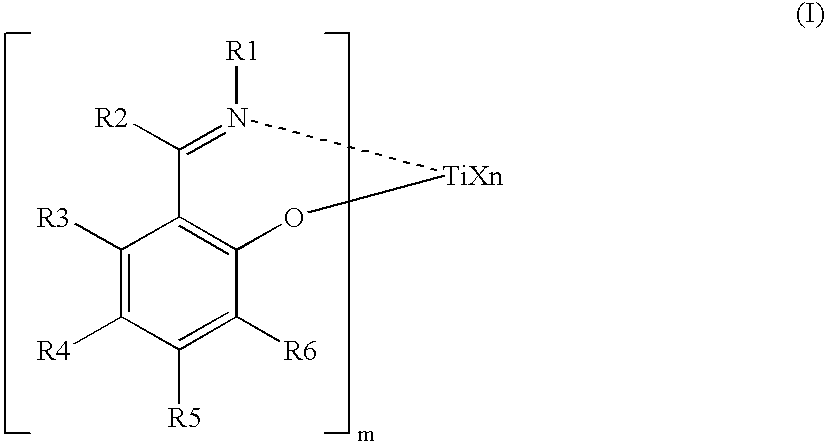Process for producing ethylene /alpha-olefin/unconjugated polyene copolymer, and ethylene/alpha-olefin/unconjugated polyene copolymer
- Summary
- Abstract
- Description
- Claims
- Application Information
AI Technical Summary
Benefits of technology
Problems solved by technology
Method used
Image
Examples
example 1
[0403] A 1.5-L stainless steel (SUS) autoclave thoroughly purged with nitrogen was charged with 675 ml of hexane containing 1.65 ml of purified 5-ethylidene-2-norbornene (hereinafter ENB) at a temperature of 23° C. The SUS autoclave was then heated to 353.16 K (80° C.). Thereafter, propylene was introduced to a pressure of 0.63 MPaG, and subsequently ethylene was charged to achieve a total pressure of 0.8 MPaG. Next, 0.357 ml (0.75 mmol in terms of Al) of a MAO / toluene solution containing 2.1 mmol / ml of aluminum was pressed into the autoclave. Thereafter, 1.5 ml of a toluene solution containing 0.001 mmol / ml of a compound (1) (synthesized by the method described above) was pressed into the autoclave:
[0404] Polymerization was performed for 30 minutes after the compound (1) had been pressed. The pressure was maintained unchanged from that immediately after the pressing, by pressurizing the autoclave with ethylene.
[0405] After the lapse of a predetermined time, 0.5 ml of methanol wa...
example 2
[0408] A 1.5-L stainless steel (SUS) autoclave thoroughly purged with nitrogen was charged with 675 ml of hexane containing 0.91 ml of purified ENB at a temperature of 23° C. The SUS autoclave was then heated to 353.16 K (80° C.) Thereafter, propylene was introduced to a pressure of 0.63 MPaG, and subsequently ethylene was charged to achieve a total pressure of 0.8 MPaG. Next, 0.357 ml (0.75 mmol in terms of Al) of a MAO / toluene solution containing 2.1 mmol / ml of aluminum was pressed into the autoclave. Thereafter, 1.5 ml of a toluene solution containing 0.001 mmol / ml of the compound (1) was pressed into the autoclave.
[0409] Polymerization was performed for 25 minutes after the compound (1) had been pressed. The pressure was maintained unchanged from that immediately after the pressing, by pressurizing the autoclave with ethylene.
[0410] After the lapse of a predetermined time, 0.5 ml of methanol was pressed into the autoclave with nitrogen to terminate the polymerization. The poly...
example 3
[0412] A 2.0-L stainless steel (SUS) autoclave thoroughly purged with nitrogen was charged with 800 ml of hexane containing 5.2 ml of purified 5-ethylidene-2-norbornene (hereinafter ENB) at a temperature of 23° C. The SUS autoclave was further charged with 150 g of propylene and thereafter sealed. The SUS autoclave was then heated to 378.16 K (105° C.), and the pressure gauge indicated 2.2 MPaG. Thereafter, ethylene was introduced to achieve a total pressure of 2.9 MPaG. Next, 0.952 ml (2.0 mmol in terms of Al) of a MAO / toluene solution containing 2.1 mmol / ml of aluminum was pressed into the autoclave. Thereafter, 4.0 ml of a toluene solution containing 0.001 mmol / ml of the compound (1) was pressed into the autoclave.
[0413] Polymerization was performed for 30 minutes after the compound (1) had been pressed. The pressure was maintained unchanged from that immediately after the pressing, by pressurizing the autoclave with ethylene. After the lapse of a predetermined time, 0.5 ml of m...
PUM
| Property | Measurement | Unit |
|---|---|---|
| Temperature | aaaaa | aaaaa |
| Temperature | aaaaa | aaaaa |
| Temperature | aaaaa | aaaaa |
Abstract
Description
Claims
Application Information
 Login to View More
Login to View More - R&D Engineer
- R&D Manager
- IP Professional
- Industry Leading Data Capabilities
- Powerful AI technology
- Patent DNA Extraction
Browse by: Latest US Patents, China's latest patents, Technical Efficacy Thesaurus, Application Domain, Technology Topic, Popular Technical Reports.
© 2024 PatSnap. All rights reserved.Legal|Privacy policy|Modern Slavery Act Transparency Statement|Sitemap|About US| Contact US: help@patsnap.com










